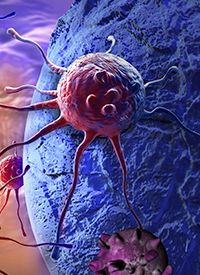Publication
Article
Cytokines Play Integral Role in Cancer Immune Cycle
Author(s):
In the setting of cancer, cytokines contribute to cells’ antitumor response, cell damage, inflammation, angiogenesis, metastasis, and other cellular processes that enable tumor survival
Cytokines in Cancer | Image Credit:
© vitanovski - stock.adobe.com

Cytokine is an umbrella term for small proteins that exert a broad range of functions such as supporting cell growth and differentiation and delivering inflammatory or anti-inflammatory messages to cells.1,2
Specific names are given to cytokines based on the type of cell that produces them or according to the action they exert in the body. For example, the term interleukin (IL) is originally derived from leukocytes but since their initial identification, many other cells have been shown to produce IL.1 Likewise, interferons (IFNs) are named for their ability to “interfere” with the multiplication of viruses.3
In the setting of cancer, cytokines contribute to cells’ antitumor response, cell damage, inflammation, angiogenesis, metastasis, and other cellular processes that enable tumor survival.4 Moreover, they play diverse roles in the immune system, variously stimulating or inhibiting an anticancer immune response (Figure).5
Figure. Cytokines at Work in the Immune Cycle

Cytokines exert their effects through signal transduction. Each cytokine has a corresponding cell-surface receptor that is located on the cytokine’s target cell. Cytokine binding prompts intracellular signaling; for example, when the cytokine IL-2 binds to receptors on natural killer (NK) cells and T lymphocytes, phosphorylation of specific enzymes such as JAK1, JAK3, STAT3, and STAT5, occurs, leading to gene transcription and subsequent cellular activity.2
ILs encompass several types of proteins that regulate immune and inflammatory responses between lymphocytes.1 For example, IL-2 is secreted by activated CD4-positive T cells and stimulates the production of cytotoxic T cells and NK cells.2,6 IL-7 is a T-cell homeostatic cytokine that facilitates lymphocyte development and survival.7 IL-12 induces T-helper 1 cell differentiation and increases the activation and cytotoxic capability of T and NK cells.6 Lastly, IL-15, produced by activated myeloid cells (eg, monocytes, macrophages, dendritic cells), supports NK cell growth and memory CD8-positive T cell homeostasis.6
IFNs are classified into distinct subtypes: types I, II, and III.3 Type I includes IFN-α with 13 t(14) subtypes, IFN-β, IFN-ε, IFN-κ, FN-ω, IFN-δ, IFN-ζ, and IFN-τ.8 They are responsible for propagating antiviral immune responses during the early stages of infection, notably inciting NK cell activity, which produces type II IFN.8 Type II IFN (also known as IFN-γ) has similar functions as type 1 IFNs in that it inhibits viral replication, but is thought to exhibit less potent effects.8 Type III IFNs (also known as IFN-λ) include IFN-λ1 (IL-28A), IFN-λ2, (IL-28B), and IFN-λ3 (IL-29).3 Type III IFNs exhibit antiviral effects primarily in epithelial tissue.6
References
- Justiz Vaillant AA, Qurie A. Interleukin. In: StatPearls. Updated August 22, 2022. Accessed February 4, 2023. https://www.ncbi.nlm.nih.gov/books/NBK499840/
- Berraondo P, Sanmamed MF, Ochoa MC, et al. Cytokines in clinical cancer immunotherapy. Br J Cancer. 2019;120(1):6-15. doi:10.1038/s41416-018-0328-y
- Negishi H, Taniguchi T, Yanai H. The interferon (IFN) class of cytokines and the IFN regulatory factor (IRF) transcription factor family. Cold Spring Harb Perspect Biol. 2018;10(11):a028423. doi:10.1101/cshperspect. a028423
- Morris RM, Mortimer TO, O’Neill KL. Cytokines: can cancer get the message? Cancers (Basel). 2022; 14(9):2178. doi:10.3390/cancers14092178
- Qiu Y, Su M, Liu L, Tang Y, Pan Y, Sun J. Clinical application of cytokines in cancer immunotherapy. Drug Des Devel Ther. 2021;15:2269-2287. doi:10.2147/DDDT.S308578
- Xue D, Hsu E, Fu YX, Peng H. Next-generation cytokines for cancer immunotherapy. Antib Ther. 2021;4(2):123133. doi:10.1093/abt/tbab014
- Chen D, Tang TX, Deng H, Yang XP, Tang ZH. Interleukin-7 biology and its effects on immune cells: mediator of generation, differentiation, survival, and homeostasis. Front Immunol. 2021;12:747324. doi:10.3389/ fimmu.2021.747324
- Lee AJ, Ashkar AA. The dual nature of type I and type II interferons. Front Immunol. 2018;9:2061. doi:10.3389/fimmu.2018.02061







